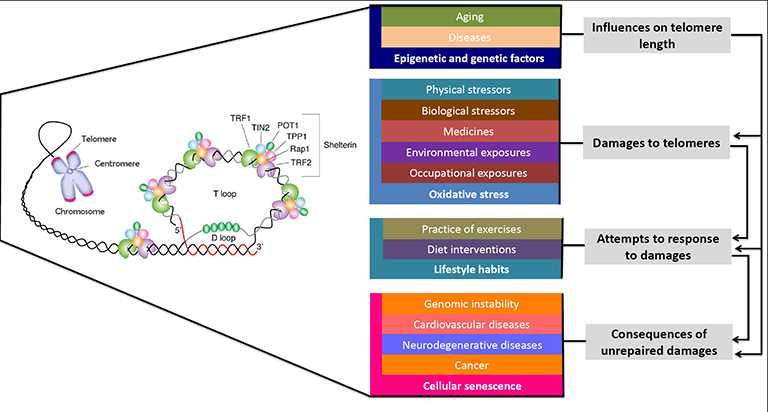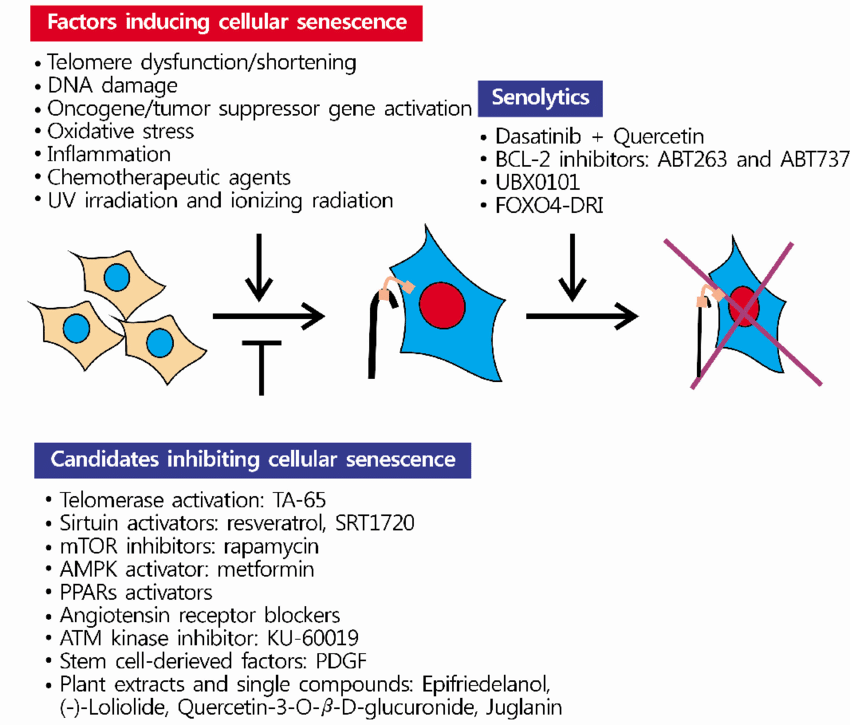When it comes to longevity, the goal is to extend healthy human lifespan—not just living longer, but living better. This field spans lifestyle, medicine, biotech, and emerging technologies.
However, although modern methods may enable a few people to live longer than 120 years, more people nowadays develop age-dependent diseases at increasingly younger ages. We need to focus on the healthspan.
Key Concepts in Longevity
Healthspan vs. Lifespan
Lifespan: How long you live.
Healthspan: How long you stay healthy and functional.
Longevity research is increasingly focusing on extending the healthspan.
Hallmarks of Ageing
Core biological processes thought to drive ageing:
Genomic instability, Telomere attrition
Epigenetic alterations, Loss of proteostasis
Deregulated nutrient sensing, Mitochondrial dysfunction
Cellular senescence, Stem cell exhaustion
Altered intercellular communication
Loss of microbiota diversity
Biological Age vs. Chronological Age
Tools now measure “biological age” through biomarkers (e.g. epigenetic clocks).
Senescence and Senolytics
Ageing cells stop dividing but remain metabolically active, contributing to inflammation.
Senolytics: Drugs that selectively eliminate senescent cells.
Caloric Restriction and Fasting
Proven in animal models to increase lifespan and improve metabolic health.
Includes intermittent fasting, time-restricted eating, and fasting-mimicking diets.
Products, Technologies
Supplements & Nutraceuticals:
-
NMN/NAD+ boosters (e.g., Elysium, Tru Niagen) – support mitochondrial function.
-
Resveratrol – activates sirtuins; found in red wine.
-
Spermidine – promotes autophagy (cellular cleanup).
-
Fisetin & Quercetin – senolytic flavonoids.
-
Omega-3s, vitamin D3, and magnesium – for overall longevity and metabolic support.
- The best mix of epigenetically active plant ingredients: timeblock
Wearables & Monitoring:
WHOOP, Oura Ring, Biostrap – monitor sleep, HRV, recovery, and more.
Levels, ZOE, Nutrisense – continuous glucose monitoring for diet optimisation.
Biological age tests – e.g., HealthbioCare, Zymo Research, InsideTracker.
Substances that selectively eliminate senescent ( Zombie cells), which accumulate with age and contribute to age-related diseases.
Rapamycin – mTOR inhibitor being studied for anti-aging, But immune- suppressive!
Metformin – diabetes drug shown to possibly slow aging-related decline, but affects microbiota
Senolytic additives:
Fisetin, EGCG, Phloretin, Quercetin
Curcumin; but these polyphenols often have a bad bioavailability, look for encapsulated products
drugs – e.g., Unity Biotechnology (in development).
Stem cell therapy – regenerative medicine potential for tissues/organs.
Physical therapies: these often are based on the principle of hormesis >>>, the positive effect of a small, short stress
Oxygen Therapy (e.g., Hyperbaric Oxygen Therapy – HBOT)
Description: Involves breathing pure oxygen in a pressurized room or chamber to enhance oxygen delivery to tissues.
Benefits:
-
May improve cognitive function, particularly in older adults.
-
Promotes wound healing and tissue repair.
-
Potential to reduce inflammation and enhance mitochondrial function.
-
May support cardiovascular health and stem cell mobilization.
Limitations:
-
Expensive and not widely available.
-
Requires medical supervision; not suitable for people with certain lung diseases or untreated pneumothorax.
-
Evidence for anti-aging effects is still emerging and not conclusive.
Cold Therapy (e.g.Cryotherapy, Cold Showers, Ice Baths)
Description: Exposure to cold temperatures to reduce inflammation and stimulate metabolic processes.
Benefits:
-
Reduces inflammation and muscle soreness.
-
May enhance immune function and circulation.
-
Triggers brown fat activation, potentially aiding metabolism.
-
Some report improved mood and mental clarity.
Limitations:
-
Can be uncomfortable or unsafe for people with cardiovascular conditions.
-
Long-term anti-aging benefits are not fully established.
-
Overuse may blunt muscle recovery in strength training contexts.
Red Light Therapy (Photobiomodulation)
Description: Uses low-level red or near-infrared light to stimulate cellular processes.
Benefits:
-
May support collagen production, skin health, and wound healing.
-
Possible improvement in muscle recovery and joint pain.
-
Can aid mitochondrial function, supporting energy metabolism.
Limitations:
-
Requires consistent use over time.
-
Limited access to high-quality devices.
-
Research is still developing on aging-specific outcomes.
Heat Therapy (e.g., Sauna, Infrared Sauna, Hot Baths) These methods sound a bit old-fashioned, but combine heat- and cryotherapy and may therefore be a simple effective treatment
Description: Use of heat to increase circulation, promote relaxation, and support detoxification.
Benefits:
-
Supports cardiovascular health and blood pressure regulation.
-
May improve longevity markers (e.g., reduced all-cause mortality in sauna users).
-
Promotes detoxification via sweating and reduces stress.
Limitations:
-
Risk of dehydration and overheating.
-
Not suitable for people with certain heart or kidney conditions.
-
Needs regular access and time commitment.
Physical Exercise Therapy
Description: Includes strength training, aerobic exercise, and flexibility work.
Benefits:
-
Slows muscle loss (sarcopenia) and improves mobility.
-
Supports bone density, reducing fracture risk.
-
Enhances brain function and mood.
-
Improves insulin sensitivity and cardiovascular health.
Limitations:
-
Risk of injury without proper guidance.
-
Requires consistency and individualized programming.
-
May be difficult for those with severe mobility issues or chronic pain.
Future Directions Experimental Areas
-
AI-driven drug discovery (e.g., Insilico Medicine).
-
Personalized longevity plans using epigenetic, microbiome, and metabolic data.
-
Cryonics and brain preservation (still fringe, e.g., Alcor).
-
Synthetic biology and organ printing for replacement parts.
-
Microbiome modulation for systemic inflammation and aging.





Therapy with Natural Killer (NK) cells
NK cells are a vital component of the innate immune system, playing a key role in immune surveillance by targeting infected or abnormal cells, such as virus-infected or cancerous cells. Recent interest has grown around NK cell therapy as a strategy to promote healthy aging and mitigate age-associated diseases.
NK Cell Function and Aging:
NK cells decline in function and number with age, contributing to immunosenescence (aging of the immune system).
This decline is linked to increased infections, cancer risk, and chronic inflammation in older adults.
What is NK Cell Therapy?
NK cell therapy involves isolating, expanding, and activating NK cells outside the body and reinfusing them.
These cells can be autologous (from the patient) or allogeneic (from a donor), with allogeneic cells often derived from umbilical cord blood or peripheral blood.Benefits for Healthy Aging:
Immune rejuvenation: Enhances immune function and reduces chronic low-grade inflammation (“inflammaging”).
Cancer prevention: Boosts surveillance and elimination of senescent or pre-malignant cells.
Tissue repair and regeneration: NK cells may support tissue homeostasis through cytokine production.
Reduction in viral reactivation: Particularly effective against latent viruses like CMV and EBV, which can become problematic in older adults.
Clinical Evidence:
- Early-phase clinical trials have shown NK cell therapy to be safe and well-tolerated.
- Some studies report improvements in inflammatory markers, immune profiles, and biological age indicators (e.g., epigenetic clocks)
Can be done with our partners in Bangkok >>>
Gene Therapy & Reprogramming, still in an early experimental phase
Partial cellular reprogramming (Yamanaka factors) is a frontier in reversing aging.
Stem Cell Therapy in Longevity
Unless this therapy is not focused on a specific medical situation under control in a publicly licensed clinic, I discourage the present use of this therapy. Famous clinics such as the Clinique La Prairie (Montreux), offering luxury beauty stem cell therapies, had to stop these therapies.
Stem cells—especially mesenchymal stem cells (MSCs), hematopoietic stem cells (HSCs), and induced pluripotent stem cells (iPSCs)—are being explored for their potential to:
-
Regenerate damaged tissues
-
Restore organ function
-
Rejuvenate the immune system
-
Delay or reverse age-related decline
Early studies have shown that stem cell therapies may:
-
Improve markers of biological aging (e.g., epigenetic clocks)
-
Reduce chronic inflammation (inflammaging)
-
Enhance cognitive and physical performance
-
Extend lifespan in animal models
However, these effects are often modest and vary widely between individuals and species.
Scientific and Technical Challenges
Uncertain Mechanisms
-
It is still unclear how exactly stem cells exert anti-aging effects. Some benefits may come not from long-term engraftment, but from paracrine signaling (e.g., secretion of growth factors or exosomes).
Stem Cell Exhaustion and Mutation Risk
Endogenous stem cell populations decline with age, and introducing new cells doesn’t always reverse this.
iPSC reprogramming carries a risk of oncogenesis due to genetic instability.
Over-proliferation or misdirected differentiation can lead to fibrosis or tumor formation.
Immunological Barriers
Allogeneic (donor-derived) stem cells may be rejected or trigger immune reactions.
Autologous (self-derived) stem cells from aged individuals often have reduced regenerative capacity.
Ethical and Regulatory Concerns
Unregulated clinics offer unproven “stem cell anti-aging” treatments, sometimes with fraudulent claims and patient harm.
Informed consent and transparency are lacking in many commercial settings.
There’s a risk of hype outpacing science, drawing vulnerable aging individuals into expensive and potentially harmful procedures.
Regulatory bodies like the FDA and EMA have called for more stringent oversight, but the market continues to grow.
Current stem cell therapies are extremely expensive, often costing tens of thousands of dollars per treatment.
Your content goes here. Edit or remove this text inline or in the module Content settings. You can also style every aspect of this content in the module Design settings and even apply custom CSS to this text in the module Advanced settings.




